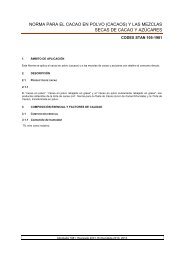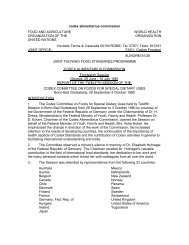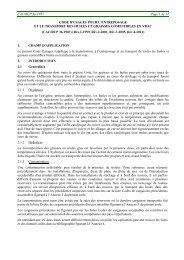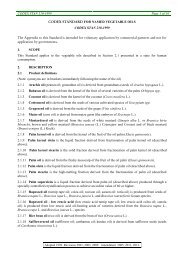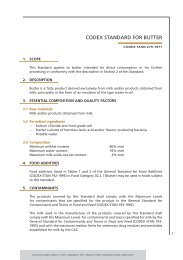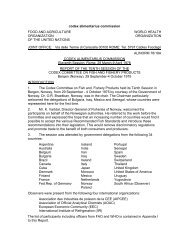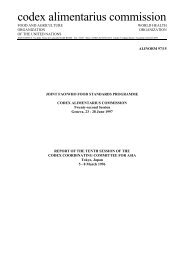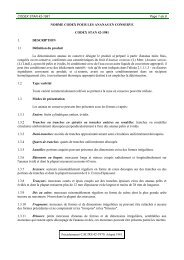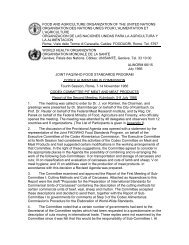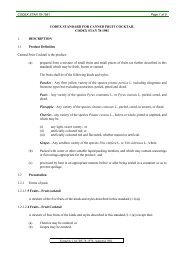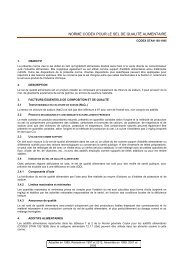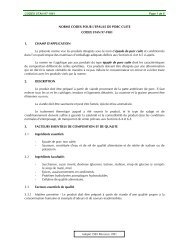REP13/FH JOINT FAO/WHO FOOD STANDARDS PROGRAMME ...
REP13/FH JOINT FAO/WHO FOOD STANDARDS PROGRAMME ...
REP13/FH JOINT FAO/WHO FOOD STANDARDS PROGRAMME ...
You also want an ePaper? Increase the reach of your titles
YUMPU automatically turns print PDFs into web optimized ePapers that Google loves.
<strong>REP13</strong>/<strong>FH</strong> 3<br />
18. The Representative of <strong>FAO</strong> presented the outcome of the work that had been undertaken by <strong>FAO</strong> and<br />
<strong>WHO</strong> in response to the request of the 42 nd Session to identify the parasite/commodity combinations of<br />
greatest concern. Particular reference was made to the approach that had been taken to address this<br />
request including holding an expert meeting, and it was noted that the multi-criteria based approach was<br />
developed and documented in such a way as to facilitate its application at country or regional level. The<br />
outcome of the ranking was considered to represent a “picture” in time and might need to be updated as<br />
further information comes available. Furthermore, as the weighting applied to each of the criteria was<br />
independent from the scoring along the criteria, alternative weighting schemes reflecting the judgement of<br />
risk managers could be used to reflect their priorities in the ranking process. The expert meeting also<br />
provided information on food attribution, potential control measures for the top third of the ranked parasites<br />
as well as details on the extent of trade in the commodities of concern and existing risk management<br />
measures.<br />
19. The <strong>FAO</strong> Representative also provided the Committee with an update on the data collection work on<br />
Vibrio spp in seafoods which had been recommended by the 42 nd Session noting the upcoming workshop in<br />
South-East Asia and the plans to implement similar workshops in other regions, resources permitting, in<br />
order to build a core expertise in Vibrio methodology to support data collection at regional level.<br />
20. Reference was also made to the recently convened Expert Meeting on the Global View of<br />
Campylobacteriosis convened by <strong>WHO</strong> in collaboration with <strong>FAO</strong> and OIE and in particular the discussions<br />
on control of Campylobacter. The Representative also extended the appreciation of <strong>FAO</strong> and <strong>WHO</strong> to all the<br />
experts and data providers who in the course of the year had made the abovementioned work possible.<br />
21. The Committee expressed their appreciation to <strong>FAO</strong> and <strong>WHO</strong> for its work on the provision of<br />
scientific advice which was essential for the Committee to undertake numerous aspects of its work.<br />
INFORMATION FROM THE WORLD ORGANIZATION FOR ANIMAL HEALTH (OIE) (Agenda Item 3b)<br />
22. In addition to information provided in CX/<strong>FH</strong> 12/44/5, the Observer from OIE informed the Committee<br />
of on-going work on the revision of the OIE Terrestrial Animal Health Code Chapter 8.13 on trichinellosis.<br />
This revised draft chapter provides recommendations for on-farm prevention of Trichinella infection in<br />
domestic pigs, and safe trade of meat and meat products derived from suids and equids. The focus is on<br />
requirements for establishing a ‘negligible risk compartment’ because there is a clear and objective means of<br />
establishing this status in pigs kept under controlled management conditions. The articles dealing with<br />
international trade of meat and meat products of suids and equids include a cross reference to the relevant<br />
Codex Guidelines.<br />
23. The Observer from OIE informed the Committee of the latest meeting of the ad hoc Group on zoonotic<br />
parasites, which revised the draft chapter taking into account OIE Member comments, and had also included<br />
the two co-chairs of the CC<strong>FH</strong> Working Group on Guidelines for Control of Specific Zoonotic Parasites. She<br />
noted that the participation of the co-chairs provided an excellent opportunity for OIE and Codex to work<br />
closely together to ensure alignment of risk-based recommendations while avoiding duplication of effort, and<br />
overlap and gaps on the development of respective standards on Trichinella.<br />
24. In addition, the Observer noted that OIE encourages its national delegates to collaborate with national<br />
Delegates to the Codex, to ensure alignment of respective standards on Trichinella under development by<br />
the OIE and Codex, and encouraged the delegates to the Codex to collaborate with national Delegates to<br />
OIE.<br />
25. The Observer confirmed OIE’s commitment to continue to explore ways to harmonise OIE and Codex<br />
approaches in the development of standards of mutual interest in the food production continuum and their<br />
willingness to participate in the electronic working group established by the Committee on General Principles<br />
(CCGP) where this will be considered.<br />
26. The Committee thanked the Observer from OIE for the useful information and their participation in<br />
CC<strong>FH</strong> work and reiterated the importance of collaboration between Codex and OIE.



